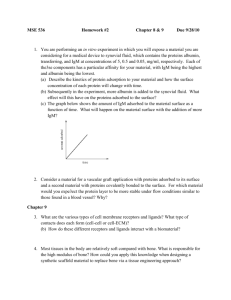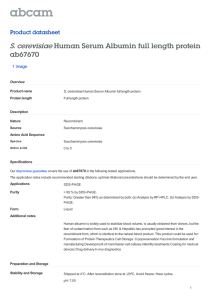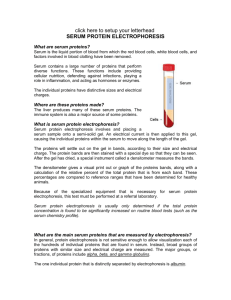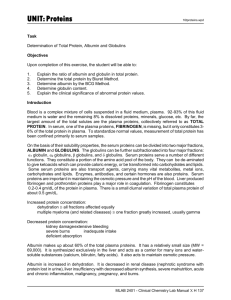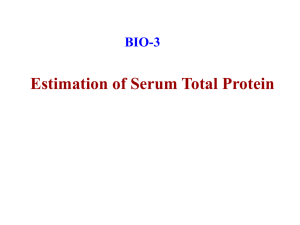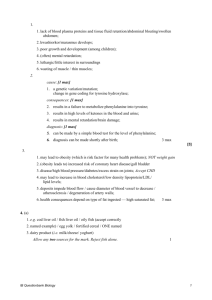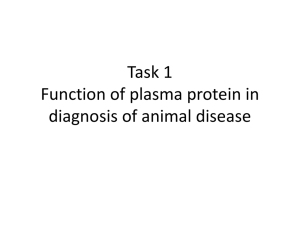PLASMA PROTEINS
advertisement
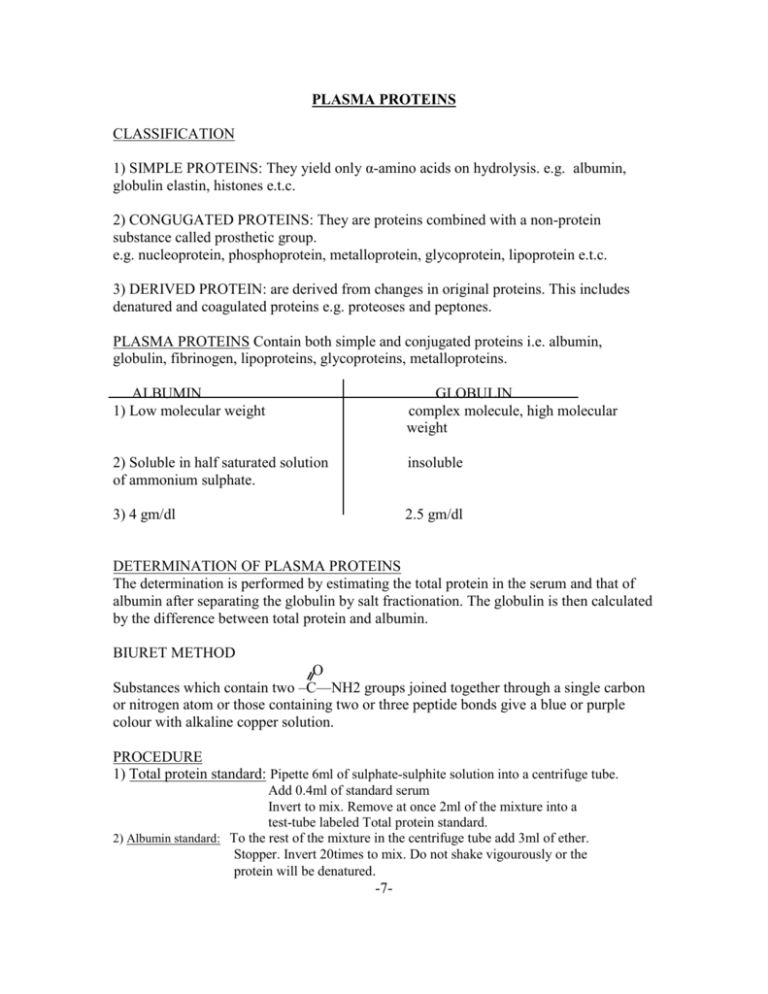
PLASMA PROTEINS CLASSIFICATION 1) SIMPLE PROTEINS: They yield only α-amino acids on hydrolysis. e.g. albumin, globulin elastin, histones e.t.c. 2) CONGUGATED PROTEINS: They are proteins combined with a non-protein substance called prosthetic group. e.g. nucleoprotein, phosphoprotein, metalloprotein, glycoprotein, lipoprotein e.t.c. 3) DERIVED PROTEIN: are derived from changes in original proteins. This includes denatured and coagulated proteins e.g. proteoses and peptones. PLASMA PROTEINS Contain both simple and conjugated proteins i.e. albumin, globulin, fibrinogen, lipoproteins, glycoproteins, metalloproteins. ALBUMIN 1) Low molecular weight GLOBULIN complex molecule, high molecular weight 2) Soluble in half saturated solution of ammonium sulphate. insoluble 3) 4 gm/dl 2.5 gm/dl DETERMINATION OF PLASMA PROTEINS The determination is performed by estimating the total protein in the serum and that of albumin after separating the globulin by salt fractionation. The globulin is then calculated by the difference between total protein and albumin. BIURET METHOD O Substances which contain two –C—NH2 groups joined together through a single carbon or nitrogen atom or those containing two or three peptide bonds give a blue or purple colour with alkaline copper solution. PROCEDURE 1) Total protein standard: Pipette 6ml of sulphate-sulphite solution into a centrifuge tube. Add 0.4ml of standard serum Invert to mix. Remove at once 2ml of the mixture into a test-tube labeled Total protein standard. 2) Albumin standard: To the rest of the mixture in the centrifuge tube add 3ml of ether. Stopper. Invert 20times to mix. Do not shake vigourously or the protein will be denatured. -7- Cap the tube and centrifuge for 5 mins so that a firm globulin layer is formed. Tilt the tube and insert a Pasteur pipette into the clear solution below the globulin layer. Do not disturb the globulin film. Withdraw this solution into a clean test tube. Measure out exactly 2ml of this solution into another test tube labeled Albumin standard. 3) TOTAL PROTEIN SAMPLE 4) ALBUMIN SAMPLE Repeat all the above steps using serum sample instead of standard serum. 5) BLANK: In a test tube labeled Blank add 2ml of sulphate-sulphite solution. Now we have 5 test tubes in all 1) Total protein standard 2) Albumin standard 3) Total protein sample 4) Albumin sample 5) Blank. To each of these add 5ml of Biuret reagent Place in a water bath at 37OC for 10 mins. Read at λ540 nm. CALCULATIONS: Abs total protein sample Serum total protein (gm/dl)= X conc. of standard ( Abs total protein std Serum albumin (gm/dl)= Abs albumin sample Abs albumin std X conc of std ( ) Serum globulin ( gm/dl) = Total protein – albumin. NORMAL VALUES: Total protein: 4.2 – 5.6 g/dl Albumin: 2.3 –3.5 g/dl. Globulin: 1.9 -2.1 gm/dl. CLINICAL SIGNIFICANCE: High level of serum proteins is called HYPERPROTEINEMIA which could be due to: 1. Dehydration 2. Shock 3. Chronic inflammations e.g: tuberculosis 4. Following surgery. 5. Cancer 6. Drugs e.g: cortisone, oral contraceptives. -8- ) Low level of serum proteins is called HYPOPROTEINEMIA which could be due to: 1. Severe hemorrhage 2. Burns 3. Malnutrition 4. Malabsorption 5. High fever causing increased catabolism of proteins 6. Acute or chronic hepatic insufficiency. -9-
